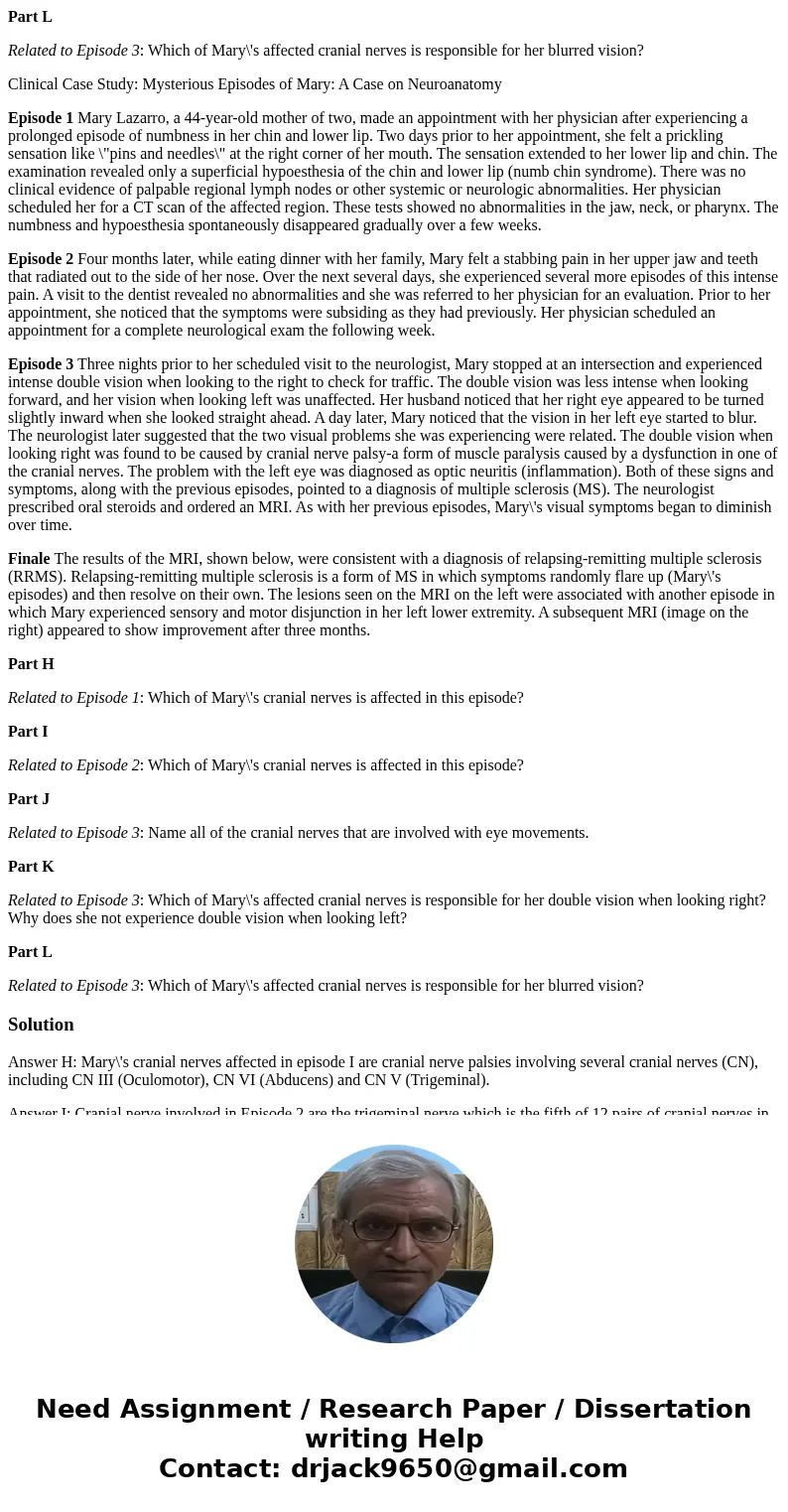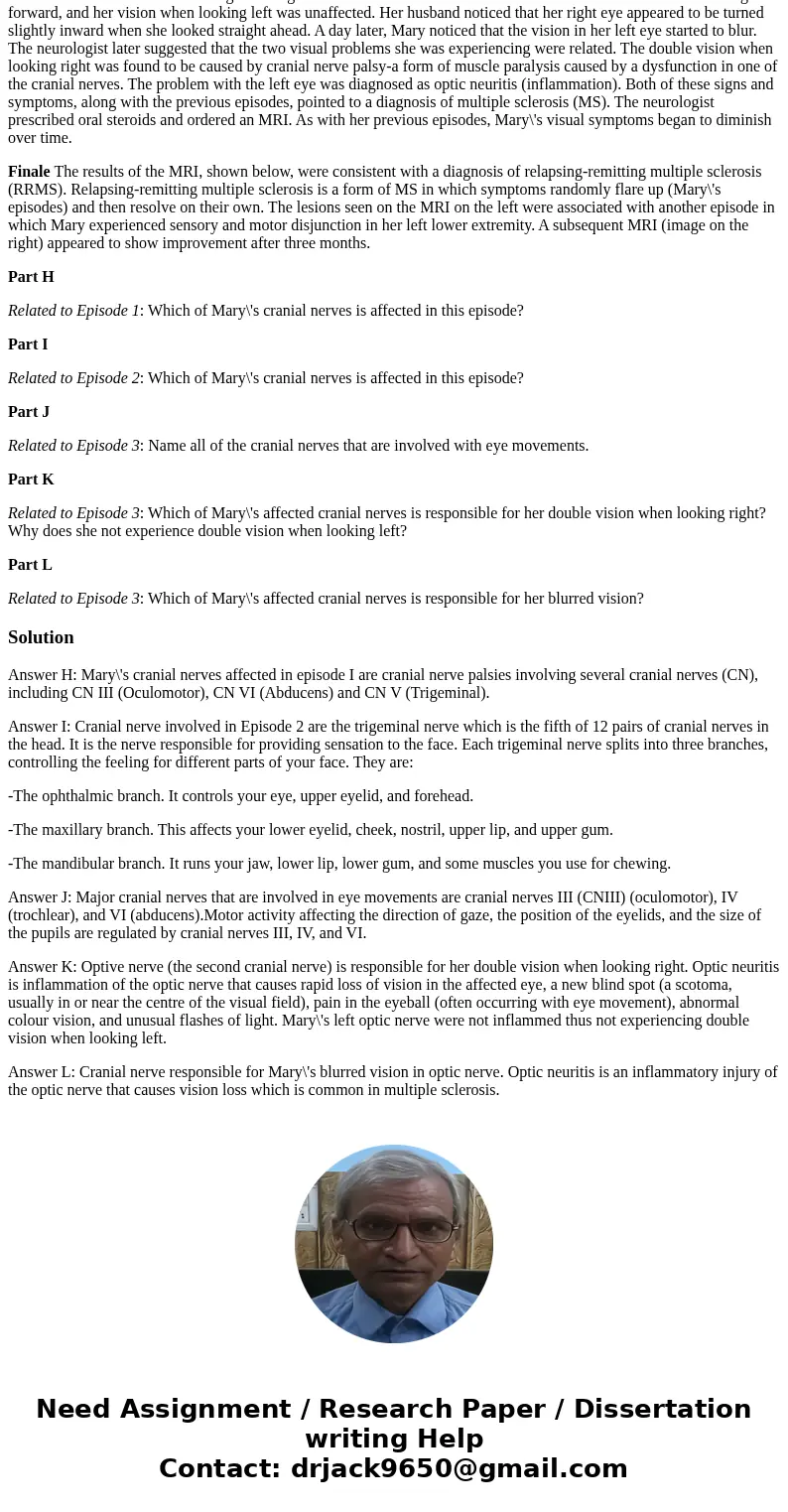Part L Related to Episode 3 Which of Marys affected cranial
Part L
Related to Episode 3: Which of Mary\'s affected cranial nerves is responsible for her blurred vision?
Clinical Case Study: Mysterious Episodes of Mary: A Case on Neuroanatomy
Episode 1 Mary Lazarro, a 44-year-old mother of two, made an appointment with her physician after experiencing a prolonged episode of numbness in her chin and lower lip. Two days prior to her appointment, she felt a prickling sensation like \"pins and needles\" at the right corner of her mouth. The sensation extended to her lower lip and chin. The examination revealed only a superficial hypoesthesia of the chin and lower lip (numb chin syndrome). There was no clinical evidence of palpable regional lymph nodes or other systemic or neurologic abnormalities. Her physician scheduled her for a CT scan of the affected region. These tests showed no abnormalities in the jaw, neck, or pharynx. The numbness and hypoesthesia spontaneously disappeared gradually over a few weeks.
Episode 2 Four months later, while eating dinner with her family, Mary felt a stabbing pain in her upper jaw and teeth that radiated out to the side of her nose. Over the next several days, she experienced several more episodes of this intense pain. A visit to the dentist revealed no abnormalities and she was referred to her physician for an evaluation. Prior to her appointment, she noticed that the symptoms were subsiding as they had previously. Her physician scheduled an appointment for a complete neurological exam the following week.
Episode 3 Three nights prior to her scheduled visit to the neurologist, Mary stopped at an intersection and experienced intense double vision when looking to the right to check for traffic. The double vision was less intense when looking forward, and her vision when looking left was unaffected. Her husband noticed that her right eye appeared to be turned slightly inward when she looked straight ahead. A day later, Mary noticed that the vision in her left eye started to blur. The neurologist later suggested that the two visual problems she was experiencing were related. The double vision when looking right was found to be caused by cranial nerve palsy-a form of muscle paralysis caused by a dysfunction in one of the cranial nerves. The problem with the left eye was diagnosed as optic neuritis (inflammation). Both of these signs and symptoms, along with the previous episodes, pointed to a diagnosis of multiple sclerosis (MS). The neurologist prescribed oral steroids and ordered an MRI. As with her previous episodes, Mary\'s visual symptoms began to diminish over time.
Finale The results of the MRI, shown below, were consistent with a diagnosis of relapsing-remitting multiple sclerosis (RRMS). Relapsing-remitting multiple sclerosis is a form of MS in which symptoms randomly flare up (Mary\'s episodes) and then resolve on their own. The lesions seen on the MRI on the left were associated with another episode in which Mary experienced sensory and motor disjunction in her left lower extremity. A subsequent MRI (image on the right) appeared to show improvement after three months.
Part H
Related to Episode 1: Which of Mary\'s cranial nerves is affected in this episode?
Part I
Related to Episode 2: Which of Mary\'s cranial nerves is affected in this episode?
Part J
Related to Episode 3: Name all of the cranial nerves that are involved with eye movements.
Part K
Related to Episode 3: Which of Mary\'s affected cranial nerves is responsible for her double vision when looking right? Why does she not experience double vision when looking left?
Part L
Related to Episode 3: Which of Mary\'s affected cranial nerves is responsible for her blurred vision?
Solution
Answer H: Mary\'s cranial nerves affected in episode I are cranial nerve palsies involving several cranial nerves (CN), including CN III (Oculomotor), CN VI (Abducens) and CN V (Trigeminal).
Answer I: Cranial nerve involved in Episode 2 are the trigeminal nerve which is the fifth of 12 pairs of cranial nerves in the head. It is the nerve responsible for providing sensation to the face. Each trigeminal nerve splits into three branches, controlling the feeling for different parts of your face. They are:
-The ophthalmic branch. It controls your eye, upper eyelid, and forehead.
-The maxillary branch. This affects your lower eyelid, cheek, nostril, upper lip, and upper gum.
-The mandibular branch. It runs your jaw, lower lip, lower gum, and some muscles you use for chewing.
Answer J: Major cranial nerves that are involved in eye movements are cranial nerves III (CNIII) (oculomotor), IV (trochlear), and VI (abducens).Motor activity affecting the direction of gaze, the position of the eyelids, and the size of the pupils are regulated by cranial nerves III, IV, and VI.
Answer K: Optive nerve (the second cranial nerve) is responsible for her double vision when looking right. Optic neuritis is inflammation of the optic nerve that causes rapid loss of vision in the affected eye, a new blind spot (a scotoma, usually in or near the centre of the visual field), pain in the eyeball (often occurring with eye movement), abnormal colour vision, and unusual flashes of light. Mary\'s left optic nerve were not inflammed thus not experiencing double vision when looking left.
Answer L: Cranial nerve responsible for Mary\'s blurred vision in optic nerve. Optic neuritis is an inflammatory injury of the optic nerve that causes vision loss which is common in multiple sclerosis.


 Homework Sourse
Homework Sourse